Detecting Climate Driven Changes in Chlorophyll-a Using High Frequency Monitoring: The Impact of the 2019 European Heatwave in Three Contrasting Aquatic Systems
Abstract
1. Introduction
2. Study Areas
2.1. Lake Trasimeno
2.2. Curonian Lagoon
2.3. Lake Võrtsjärv
3. Materials and Methods
4. Results
5. Discussion
6. Conclusions
Supplementary Materials
Author Contributions
Funding
Institutional Review Board Statement
Informed Consent Statement
Data Availability Statement
Acknowledgments
Conflicts of Interest
References
- Likens, G.E. Lake ecosystem ecology: A global perspective. In Encyclopedia of Inland Waters; Academic Press: Cambridge, MA, USA, 2010. [Google Scholar]
- Lewis, W.M. Lakes as Ecosystems. In Encyclopedia of Inland Waters; Academic Press: Cambridge, MA, USA, 2014; ISBN 978-0-12-409548-9. [Google Scholar]
- Michalak, A.M. Study role of climate change in extreme threats to water quality. Nature 2016, 535, 349–350. [Google Scholar] [CrossRef] [PubMed]
- Bennett, M.G.; Schofield, K.A.; Lee, S.S.; Norton, S.B. Response of chlorophyll a to total nitrogen and total phosphorus concentrations in lotic ecosystems: A systematic review protocol. Environ. Évid. 2017, 6, 1–13. [Google Scholar] [CrossRef] [PubMed]
- Reid, A.J.; Carlson, A.K.; Creed, I.F.; Eliason, E.J.; Gell, P.A.; Johnson, P.T.J.; Kidd, K.A.; MacCormack, T.J.; Olden, J.D.; Ormerod, S.J.; et al. Emerging threats and persistent conservation challenges for freshwater biodiversity. Biol. Rev. 2018, 94, 849–873. [Google Scholar] [CrossRef]
- Le Moal, M.; Gascuel-Odoux, C.; Ménesguen, A.; Souchon, Y.; Étrillard, C.; Levain, A.; Moatar, F.; Pannard, A.; Souchu, P.; Lefebvre, A.; et al. Eutrophication: A new wine in an old bottle? Sci. Total Environ. 2018, 651, 1–11. [Google Scholar] [CrossRef] [PubMed]
- Carpenter, S.R. Phosphorus control is critical to mitigating eutrophication. Proc. Natl. Acad. Sci. USA 2008, 105, 11039–11040. [Google Scholar] [CrossRef]
- Conley, D.J.; Paerl, H.W.; Howarth, R.; Boesch, D.F.; Seitzinger, S.P.; Havens, K.E.; Lancelot, C.; Likens, G.E. ECOLOGY: Controlling Eutrophication: Nitrogen and Phosphorus. Science 2009, 323, 1014–1015. [Google Scholar] [CrossRef]
- Siegel, D.; Behrenfeld, M.; Maritorena, S.; McClain, C.; Antoine, D.; Bailey, S.; Bontempi, P.; Boss, E.; Dierssen, H.; Doney, S.; et al. Regional to global assessments of phytoplankton dynamics from the SeaWiFS mission. Remote Sens. Environ. 2013, 135, 77–91. [Google Scholar] [CrossRef]
- Deng, Y.; Zhang, Y.; Li, D.; Shi, K.; Zhang, Y. Temporal and Spatial Dynamics of Phytoplankton Primary Production in Lake Taihu Derived from MODIS Data. Remote Sens. 2017, 9, 195. [Google Scholar] [CrossRef]
- Carpenter, S.R.; Kitchell, J.F. The Trophic Cascade in Lakes; Cambridge University Press: Cambridge, MA, USA, 1996; ISBN 978-0-521-56684-1. [Google Scholar]
- Zhang, M.; Shi, X.; Yang, Z.; Yu, Y.; Shi, L.; Qin, B. Long-term dynamics and drivers of phytoplankton biomass in eutrophic Lake Taihu. Sci. Total Environ. 2018, 645, 876–886. [Google Scholar] [CrossRef]
- Verity, P.G. Effects of temperature, irradiance, and daylength on the marine diatom Leptocylindrus danicus Cleve. IV. Growth. J. Exp. Mar. Biol. Ecol. 1982, 60, 209–222. [Google Scholar] [CrossRef]
- Palmisano, A.C.; SooHoo, J.B.; Sullivan, C.W. Effects of four environmental variables on photosynthesis-irradiance relationships in Antarctic sea-ice microalgae. Mar. Biol. 1987, 94, 299–306. [Google Scholar] [CrossRef]
- Edwards, K.F.; Thomas, M.; Klausmeier, C.A.; Litchman, E. Phytoplankton growth and the interaction of light and temperature: A synthesis at the species and community level. Limnol. Oceanogr. 2016, 61, 1232–1244. [Google Scholar] [CrossRef]
- Lucas, L.V.; Sereno, D.M.; Burau, J.R.; Schraga, T.S.; Lopez, C.B.; Stacey, M.T.; Parchevsky, K.V.; Parchevsky, V.P. Intradaily variability of water quality in a shallow tidal lagoon: Mechanisms and implications. Chesap. Sci. 2006, 29, 711–730. [Google Scholar] [CrossRef]
- Lopez, C.B.; Cloern, J.E.; Schraga, T.S.; Little, A.J.; Lucas, L.V.; Thompson, J.K.; Burau, J.R. Ecological Values of Shallow-Water Habitats: Implications for the Restoration of Disturbed Ecosystems. Ecosystems 2006, 9, 422–440. [Google Scholar] [CrossRef]
- Bresciani, M.; Rossini, M.; Morabito, G.; Matta, E.; Pinardi, M.; Cogliati, S.; Julitta, T.; Colombo, R.; Braga, F.; Giardino, C. Analysis of Within-and between-Day Chlorophyll-a Dynamics in Mantua Superior Lake, with a Continuous Spectroradiometric Measurement. Mar. Freshw. Res. 2013, 64, 303–316. [Google Scholar] [CrossRef]
- Council of the European Communities Directive 2000/60/EC of the European Parliament and of the Council of 23 October 2000 Establishing a Framework for Community Action in the Field of Water Policy. Available online: https://eur-lex.europa.eu/eli/dir/2000/60/oj (accessed on 1 July 2021).
- Council of the European Communities Commission Decision of 20 September 2013 Establishing Pursuant to Directive 2000/60/EC of the European Parliament and of the Council, the Values of the Member State Monitoring System Classifications as a Result of the Intercalibration Exercise and Repealing Decision 2008/915/EC. Off. J. Eur. Communities 2013, 480, 1–47.
- Carvalho, L.; Mackay, E.B.; Cardoso, A.C.; Baattrup-Pedersen, A.; Birk, S.; Blackstock, K.L.; Borics, G.; Borja, A.; Feld, C.K.; Ferreira, M.T.; et al. Protecting and restoring Europe’s waters: An analysis of the future development needs of the Water Framework Directive. Sci. Total Environ. 2018, 658, 1228–1238. [Google Scholar] [CrossRef]
- Richardson, S.D. Environmental Mass Spectrometry: Emerging Contaminants and Current Issues. Anal. Chem. 2008, 80, 4373–4402. [Google Scholar] [CrossRef] [PubMed]
- Zulkifli, S.N.; Rahim, H.A.; Lau, W.-J. Detection of contaminants in water supply: A review on state-of-the-art monitoring technologies and their applications. Sensors Actuators B Chem. 2017, 255, 2657–2689. [Google Scholar] [CrossRef] [PubMed]
- Demetillo, A.T.; Japitana, M.V.; Taboada, E.B. A system for monitoring water quality in a large aquatic area using wireless sensor network technology. Sustain. Environ. Res. 2019, 29, 12. [Google Scholar] [CrossRef]
- Gillett, D.; Marchiori, A. A Low-Cost Continuous Turbidity Monitor. Sensors 2019, 19, 3039. [Google Scholar] [CrossRef] [PubMed]
- Pinardi, M.; Free, G.; Lotto, B.; Ghirardi, N.; Bartoli, M.; Bresciani, M. Exploiting high frequency monitoring and satellite imagery for assessing chlorophyll-a dynamics in a shallow eutrophic lake. J. Limnol. 2021. [Google Scholar] [CrossRef]
- Arabi, B.; Salama, M.S.; Pitarch, J.; Verhoef, W. Integration of in-situ and multi-sensor satellite observations for long-term water quality monitoring in coastal areas. Remote Sens. Environ. 2020, 239, 111632. [Google Scholar] [CrossRef]
- Bresciani, M.; Pinardi, M.; Free, G.; Luciani, G.; Ghebrehiwot, S.; Laanen, M.; Peters, S.; Della Bella, V.; Padula, R.; Giardino, C. The Use of Multisource Optical Sensors to Study Phytoplankton Spatio-Temporal Variation in a Shallow Turbid Lake. Water 2020, 12, 284. [Google Scholar] [CrossRef]
- Papathanasopoulou, E.; Simis, S.; Alikas, K.; Ansper, A.; Anttila, S.; Attila, J. Satellite-Assisted Monitoring of Water Quality to Support the Implementation of the Water Framework Directive. EOMORES White Paper; European Union’s Horizon 2020 Project. Available online: https://zenodo.org/record/3903776#.YUDJ8J0zZPY (accessed on 1 July 2021).
- Hestir, E.; Brando, V.; Bresciani, M.; Giardino, C.; Matta, E.; Villa, P.; Dekker, A. Measuring freshwater aquatic ecosystems: The need for a hyperspectral global mapping satellite mission. Remote Sens. Environ. 2015, 167, 181–195. [Google Scholar] [CrossRef]
- Dörnhöfer, K.; Klinger, P.; Heege, T.; Oppelt, N. Multi-sensor satellite and in situ monitoring of phytoplankton development in a eutrophic-mesotrophic lake. Sci. Total Environ. 2018, 612, 1200–1214. [Google Scholar] [CrossRef] [PubMed]
- Wang, M.; Shi, W.; Tang, J. Water property monitoring and assessment for China’s inland Lake Taihu from MODIS-Aqua measurements. Remote Sens. Environ. 2011, 115, 841–854. [Google Scholar] [CrossRef]
- Nõges, P.; Tuvikene, L. Spatial and annual variability of environmental and phytoplankton indicators in Lake Võrtsjärv: Implications for water quality monitoring. Estonian J. Ecol. 2012, 61, 227. [Google Scholar] [CrossRef]
- Opdyke, M.R.; Ostrom, N.E.; Ostrom, P.H. Evidence for the predominance of denitrification as a source of N2O in temperate agricultural soils based on isotopologue measurements. Glob. Biogeochem. Cycles 2009, 23. [Google Scholar] [CrossRef]
- O’Neil, J.; Davis, T.; Burford, M.; Gobler, C. The rise of harmful cyanobacteria blooms: The potential roles of eutrophication and climate change. Harmful Algae 2012, 14, 313–334. [Google Scholar] [CrossRef]
- Konopka, A.; Brock, T.D. Effect of Temperature on Blue-Green Algae (Cyanobacteria) in Lake Mendota. Appl. Environ. Microbiol. 1978, 36, 572–576. [Google Scholar] [CrossRef]
- Jöhnk, K.; Huisman, J.; Sharples, J.; Sommeijer, B.; Visser, P.M.; Stroom, J.M. Summer heatwaves promote blooms of harmful cyanobacteria. Glob. Chang. Biol. 2007, 14, 495–512. [Google Scholar] [CrossRef]
- Rogora, M.; Buzzi, F.; Dresti, C.; Leoni, B.; Lepori, F.; Mosello, R.; Patelli, M.; Salmaso, N. Climatic effects on vertical mixing and deep-water oxygen content in the subalpine lakes in Italy. Hydrobiologia 2018, 824, 33–50. [Google Scholar] [CrossRef]
- Free, G.; Bresciani, M.; Pinardi, M.; Ghirardi, N.; Luciani, G.; Caroni, R.; Giardino, C. Detecting Climate Driven Changes in Chlorophyll-a in Deep Subalpine Lakes Using Long Term Satellite Data. Water 2021, 13, 866. [Google Scholar] [CrossRef]
- Maeda, E.E.; Lisboa, F.; Kaikkonen, L.; Kallio, K.; Koponen, S.; Brotas, V.; Kuikka, S. Temporal patterns of phytoplankton phenology across high latitude lakes unveiled by long-term time series of satellite data. Remote Sens. Environ. 2018, 221, 609–620. [Google Scholar] [CrossRef]
- Huber, V.; Wagner, C.; Gerten, D.; Adrian, R. To bloom or not to bloom: Contrasting responses of cyanobacteria to recent heat waves explained by critical thresholds of abiotic drivers. Oecologia 2011, 169, 245–256. [Google Scholar] [CrossRef] [PubMed]
- Havens, K.E.; Ji, G.; Beaver, J.R.; Fulton, R.S.; Teacher, C.E. Dynamics of cyanobacteria blooms are linked to the hydrology of shallow Florida lakes and provide insight into possible impacts of climate change. Hydrobiologia 2017, 829, 43–59. [Google Scholar] [CrossRef]
- Ranasinghe, R.; Ruane, A.C.; Vautard, R.; Arnell, N.; Coppola, E.; Cruz, F.A.; Dessai, S.; Islam, A.S.; Rahimi, M.; Ruiz Carrascal, D.; et al. Chapter 12: Climate change information for regional impact and for risk assessment. In Climate Change 2021: The Physical Science Basis. Contribution of Working Group I to the Sixth Assessment Report of the Intergovernmental Panel on Climate Change; Cambridge University Press: Cambridge, MA, USA, 2021. [Google Scholar]
- Woolway, R.I.; Jennings, E.; Shatwell, T.; Golub, M.; Pierson, D.C.; Maberly, S.C. Lake heatwaves under climate change. Nature 2021, 589, 402–407. [Google Scholar] [CrossRef] [PubMed]
- ECMWF. State of the European Climate: July 2019; ECMWF: Brussels, Belgium, 2019; p. 7. [Google Scholar]
- Kottek, M.; Grieser, J.; Beck, C.; Rudolf, B.; Rubel, F. World Map of the Köppen-Geiger climate classification updated. Meteorol. Z. 2006, 15, 259–263. [Google Scholar] [CrossRef]
- Ludovisi, A.; Gaino, E. Meteorological and water quality changes in Lake Trasimeno (Umbria, Italy) during the last fifty years. J. Limonol. 2010, 69, 174–188. [Google Scholar] [CrossRef]
- Cingolani, A.; Charavgis, F. Valutazione Dello Stato Ecologico e Chimico Dei Corpi Idrici Lacustri (2015–2017); ARPA: Umbria, Italy, 2018; p. 26. [Google Scholar]
- Cingolani, A.; Charavgis, F. Valutazione Dello Stato Ecologico e Chimico Dei Corpi Idrici Lacustri (2013–2015); ARPA: Umbria, Italy, 2017; p. 25. [Google Scholar]
- Havens, K.E.; Elia, A.C.; Taticchi, M.I.; Fulton, R.S. Zooplankton–phytoplankton relationships in shallow subtropical versus temperate lakes Apopka (Florida, USA) and Trasimeno (Umbria, Italy). Hydrobiologia 2009, 628, 165–175. [Google Scholar] [CrossRef]
- Charavgis, F.; Cingolani, A.; Di Brizio, M.; Rinaldi, E.; Tozzi, G.; Stranieri, P. Qualita’ Delle Acque Di Balneazione Dei Laghi Umbri, Stagione Balneare 2019; ARPA: Umbria, Italy, 2020. [Google Scholar]
- Umgiesser, G.; Zemlys, P.; Erturk, A.; Razinkova-Baziukas, A.; Mėžinė, J.; Ferrarin, C. Seasonal renewal time variability in the Curonian Lagoon caused by atmospheric and hydrographical forcing. Ocean Sci. 2016, 12, 391–402. [Google Scholar] [CrossRef]
- Christian, F.; Arturas, R.; Saulius, G.; Georg, U.; Lina, B. Hydraulic regime-based zonation scheme of the Curonian Lagoon. Hydrobiologia 2008, 611, 133–146. [Google Scholar] [CrossRef]
- Vaiciūtė, D.; Bresciani, M.; Bartoli, M.; Giardino, C.; Bučas, M. Spatial and temporal distribution of coloured dissolved organic matter in a hypertrophic freshwater lagoon. J. Limnol. 2015, 74, 572–583. [Google Scholar] [CrossRef][Green Version]
- Overlingė, D.; Kataržytė, M.; Vaičiūtė, D.; Gyraite, G.; Gečaitė, I.; Jonikaitė, E.; Mazur-Marzec, H. Are there concerns regarding cHAB in coastal bathing waters affected by freshwater-brackish continuum? Mar. Pollut. Bull. 2020, 159, 111500. [Google Scholar] [CrossRef]
- Vaičiūtė, D.; Bučas, M.; Bresciani, M.; Dabulevičienė, T.; Gintauskas, J.; Mėžinė, J.; Tiškus, E.; Umgiesser, G.; Morkūnas, J.; De Santi, F.; et al. Hot moments and hotspots of cyanobacteria hyperblooms in the Curonian Lagoon (SE Baltic Sea) revealed via remote sensing-based retrospective analysis. Sci. Total Environ. 2021, 769, 145053. [Google Scholar] [CrossRef]
- Vybernaite-Lubiene, I.; Zilius, M.; Giordani, G.; Petkuviene, J.; Vaiciute, D.; Bukaveckas, P.; Bartoli, M. Effect of algal blooms on retention of N, Si and P in Europe’s largest coastal lagoon. Estuarine, Coast. Shelf Sci. 2017, 194, 217–228. [Google Scholar] [CrossRef]
- Nõges, P.; Nõges, T.; Laas, A. Climate-related changes of phytoplankton seasonality in large shallow Lake Võrtsjärv, Estonia. Aquat. Ecosyst. Health Manag. 2010, 13, 154–163. [Google Scholar] [CrossRef]
- Laas, A.; Cremona, F.; Meinson, P.; Rõõm, E.-I.; Nõges, T.; Nõges, P. Summer depth distribution profiles of dissolved CO2 and O2 in shallow temperate lakes reveal trophic state and lake type specific differences. Sci. Total Environ. 2016, 566-567, 63–75. [Google Scholar] [CrossRef]
- Nõges, T.; Janatian, N.; Laugaste, R.; Nõges, P. Post-soviet changes in nitrogen and phosphorus stoichiometry in two large non-stratified lakes and the impact on phytoplankton. Glob. Ecol. Conserv. 2020, 24, e01369. [Google Scholar] [CrossRef]
- Peters, S.; Laanen, M.; Groetsch, P.; Ghezehegn, S.; Poser, K.; Hommersom, A.; DeReus, E.; Spaias, L. WISPstation: A New Autonomous above Water Radiometer System. 2019. Available online: https://doi.org/10.5281/zenodo.2533079 (accessed on 1 July 2021).
- Gons, H.J. Optical Teledetection of Chlorophyll a in Turbid Inland Waters. Environ. Sci. Technol. 1999, 33, 1127–1132. [Google Scholar] [CrossRef]
- Riddick, C.; Tyler, A.; Hommersom, A.; Alikas, K.; Kangro, K.; Ligi, M.; Bresciani, M.; Antilla, S.; Vaiciute, D.; Bucas, M.; et al. EOMORES D5.3: Final Validation Report. 2019. Available online: https://zenodo.org/record/4057057#.YUDLoJ0zZPY (accessed on 1 July 2021).
- McCune, B.; Mefford, M.J. PC-ORD. Multivariate Analysis of Ecological Data; MjM Software: Gleneden Beach, OR, USA, 2016. [Google Scholar]
- Venables, W.N.; Ripley, B.D. Modern Applied Statistics with S, 4th ed.; Springer: New York, NY, USA, 2002; ISBN 0-387-95457-0. [Google Scholar]
- McCune, B. Nonparametric Multiplicative Regression for Habitat Modeling; Oregon State University: Corvallis, OR, USA, 2006. [Google Scholar]
- Yost, A.C. Probabilistic modeling and mapping of plant indicator species in a Northeast Oregon industrial forest, USA. Ecol. Indic. 2008, 8, 46–56. [Google Scholar] [CrossRef]
- Ellis, C.J.; Coppins, B.J.; Dawson, T.P.; Seaward, M.R. Response of British lichens to climate change scenarios: Trends and uncertainties in the projected impact for contrasting biogeographic groups. Biol. Conserv. 2007, 140, 217–235. [Google Scholar] [CrossRef]
- Nicolaou, N.; Constandinou, T. A Nonlinear Causality Estimator Based on Non-Parametric Multiplicative Regression. Front. Aging Neurosci. 2016, 10, 19. [Google Scholar] [CrossRef] [PubMed]
- McCune, B.; Mefford, M.J. HyperNiche. Nonparametric Multiplicative Habitat Modeling; MjM Software: Gleneden Beach, OR, USA, 2009. [Google Scholar]
- McCune, B. Non-parametric habitat models with automatic interactions. J. Veg. Sci. 2006, 17, 819–830. [Google Scholar] [CrossRef]
- European Space Agency, Copernicus State-of-the-European-Climate: July 2019. Available online: https://surfobs.climate.copernicus.eu/stateoftheclimate/july2019.php (accessed on 23 June 2021).
- Hamilton, D.P.; Carey, C.C.; Arvola, L.; Arzberger, P.; Brewer, C.; Cole, J.J.; Gaiser, E.; Hanson, P.C.; Ibelings, B.W.; Jennings, E.; et al. A Global Lake Ecological Observatory Network (GLEON) for synthesising high–frequency sensor data for validation of deterministic ecological models. Inland Waters 2015, 5, 49–56. [Google Scholar] [CrossRef]
- Brentrup, J.A.; Williamson, C.E.; Colom-Montero, W.; Eckert, W.; De Eyto, E.; Grossart, H.-P.; Huot, Y.; Isles, P.D.F.; Knoll, L.B.; Leach, T.H.; et al. The potential of high-frequency profiling to assess vertical and seasonal patterns of phytoplankton dynamics in lakes: An extension of the Plankton Ecology Group (PEG) model. Inland Waters 2016, 6, 565–580. [Google Scholar] [CrossRef]
- Bartosiewicz, M.; Przytulska, A.; Deshpande, B.N.; Antoniades, D.; Cortes, A.; MacIntyre, S.; Lehmann, M.; Laurion, I. Effects of climate change and episodic heat events on cyanobacteria in a eutrophic polymictic lake. Sci. Total Environ. 2019, 693, 133414. [Google Scholar] [CrossRef] [PubMed]
- Jeppesen, E.; Audet, J.; Davidson, T.; Neif, E.; Cao, Y.; Filiz, N.; Lauridsen, T.; Larsen, S.; Beklioğlu, M.; Sh, T.; et al. Nutrient Loading, Temperature and Heat Wave Effects on Nutrients, Oxygen and Metabolism in Shallow Lake Mesocosms Pre-Adapted for 11 Years. Water 2021, 13, 127. [Google Scholar] [CrossRef]
- Søndergaard, M.; Jensen, J.P.; Jeppesen, E. Role of sediment and internal loading of phosphorus in shallow lakes. Hydrobiologia 2003, 506-509, 135–145. [Google Scholar] [CrossRef]
- Dabuleviciene, T.; Vaiciute, D.; Kozlov, I. Chlorophyll-a Variability during Upwelling Events in the South-Eastern Baltic Sea and in the Curonian Lagoon from Satellite Observations. Remote Sens. 2020, 12, 3661. [Google Scholar] [CrossRef]
- Filiz, N.; Işkın, U.; Beklioğlu, M.; Öğlü, B.; Cao, Y.; Davidson, T.A.; Søndergaard, M.; Lauridsen, T.L.; Jeppesen, E. Phytoplankton Community Response to Nutrients, Temperatures, and a Heat Wave in Shallow Lakes: An Experimental Approach. Water 2020, 12, 3394. [Google Scholar] [CrossRef]
- Stockwell, J.D.; Doubek, J.P.; Adrian, R.; Anneville, O.; Carey, C.C.; Carvalho, L.; Domis, L.N.D.S.; Dur, G.; Frassl, M.A.; Grossart, H.; et al. Storm impacts on phytoplankton community dynamics in lakes. Glob. Chang. Biol. 2020, 26, 2756–2784. [Google Scholar] [CrossRef]
- Nõges, T.; Nõges, P.; Laugaste, R. Water level as the mediator between climate change and phytoplankton composition in a large shallow temperate lake. Hydrobiologia 2003, 506-509, 257–263. [Google Scholar] [CrossRef]
- Marcé, R.; George, G.; Buscarinu, P.; Deidda, M.; Dunalska, J.; De Eyto, E.; Flaim, G.; Grossart, H.-P.; Istvanovics, V.; Lenhardt, M.; et al. Automatic High Frequency Monitoring for Improved Lake and Reservoir Management. Environ. Sci. Technol. 2016, 50, 10780–10794. [Google Scholar] [CrossRef] [PubMed]
- European Comission. A European Overview of the Second River Basin Management Plans. 5th Water Framework Directive Implementation Report; European Comission: Brussels, Belgium, 2019. [Google Scholar]
- Seifert-Dähnn, I.; Furuseth, I.S.; Vondolia, G.K.; Gal, G.; de Eyto, E.; Jennings, E.; Pierson, D. Costs and benefits of automated high-frequency environmental monitoring—The case of lake water management. J. Environ. Manag. 2021, 285, 112108. [Google Scholar] [CrossRef] [PubMed]
- Vadas, P.A.; Jokela, W.E.; Franklin, D.; Endale, D.M. The Effect of Rain and Runoff When Assessing Timing of Manure Application and Dissolved Phosphorus Loss in Runoff1. JAWRA J. Am. Water Resour. Assoc. 2011, 47, 877–886. [Google Scholar] [CrossRef]
- Williams, P.; Biggs, J.; Stoate, C.; Szczur, J.; Brown, C.; Bonney, S. Nature based measures increase freshwater biodiversity in agricultural catchments. Biol. Conserv. 2020, 244, 108515. [Google Scholar] [CrossRef]
- ECMWF. State of the European Climate: June 2019; ECMWF: Brussels, Belgium, 2019; p. 7. [Google Scholar]
- Zhang, R.; Sun, C.; Zhu, J.; Zhang, R.; Li, W. Increased European heat waves in recent decades in response to shrinking Arctic sea ice and Eurasian snow cover. NPJ Clim. Atmos. Sci. 2020, 3, 7. [Google Scholar] [CrossRef]
- Crétaux, J.-F.; Merchant, C.J.; Duguay, C.; Simis, S.; Calmettes, B.; Bergé-Nguyen, M.; Wu, Y.; Zhang, D.; Carrea, L.; Liu, X.; et al. ESA Lakes Climate Change Initiative (Lakes_cci): Lake Products, Version 1.1. 2020. Available online: https://doi.org/10.5285/ef1627f523764eae8bbb6b81bf1f7a0a (accessed on 1 July 2021).
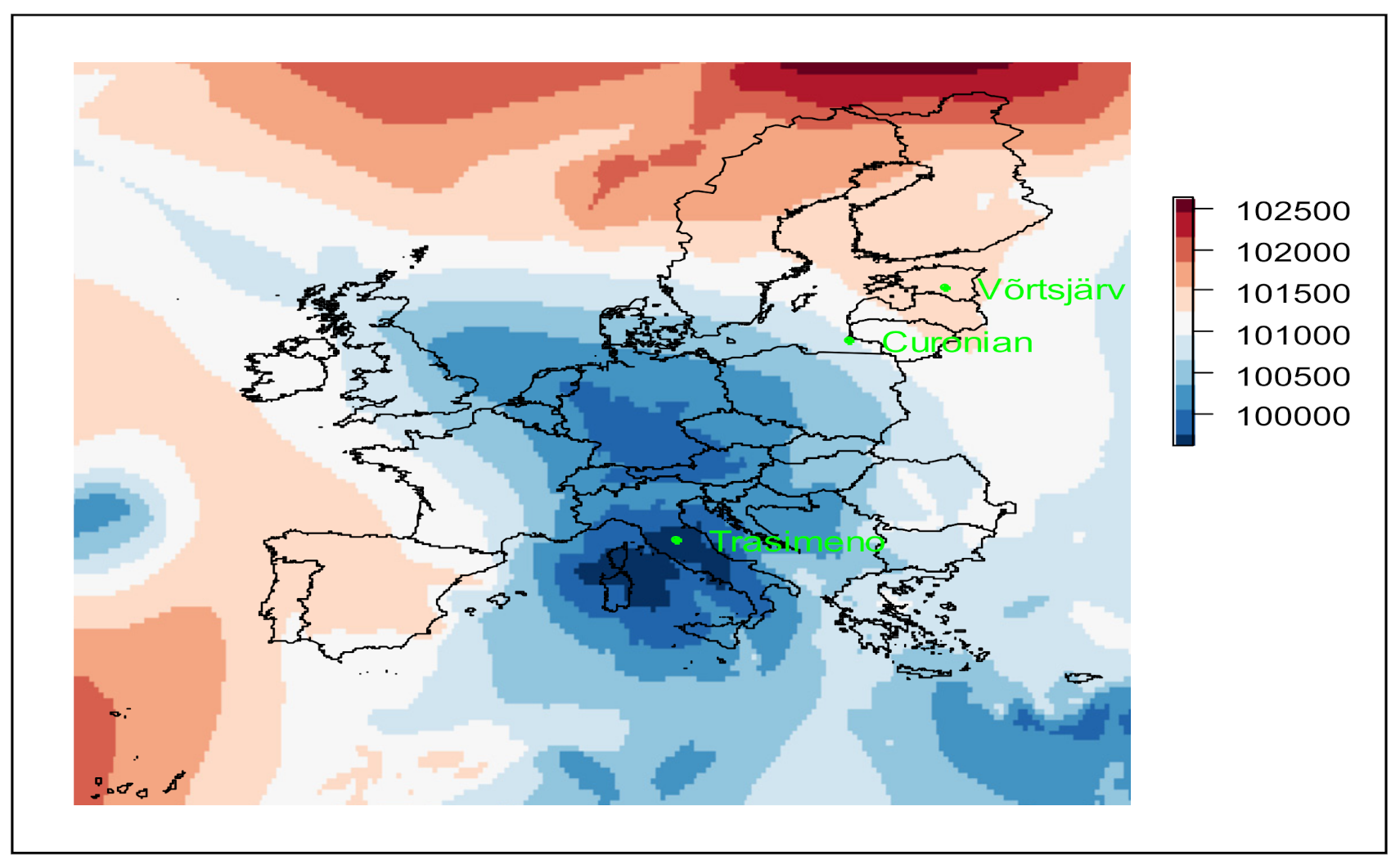
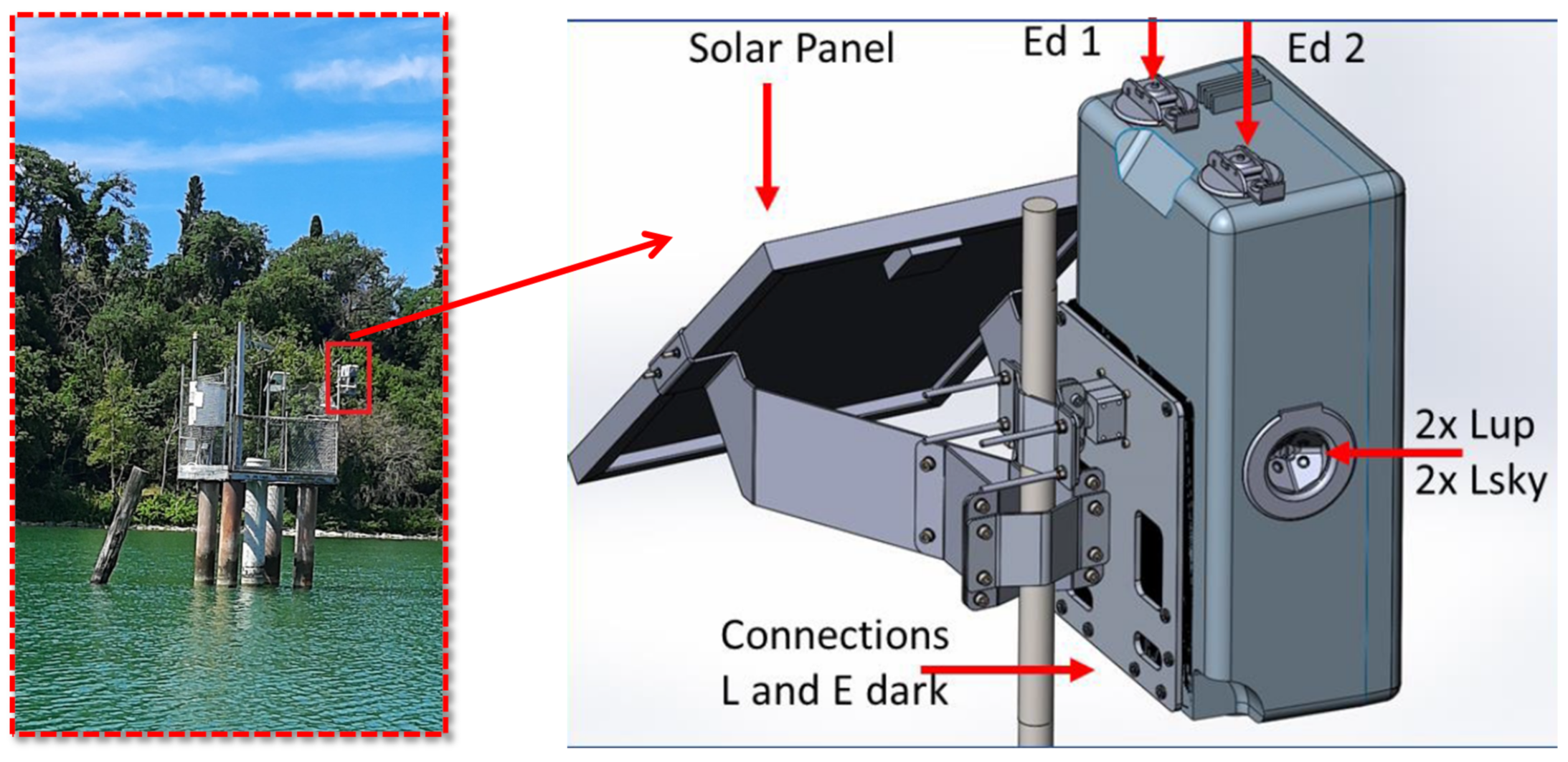
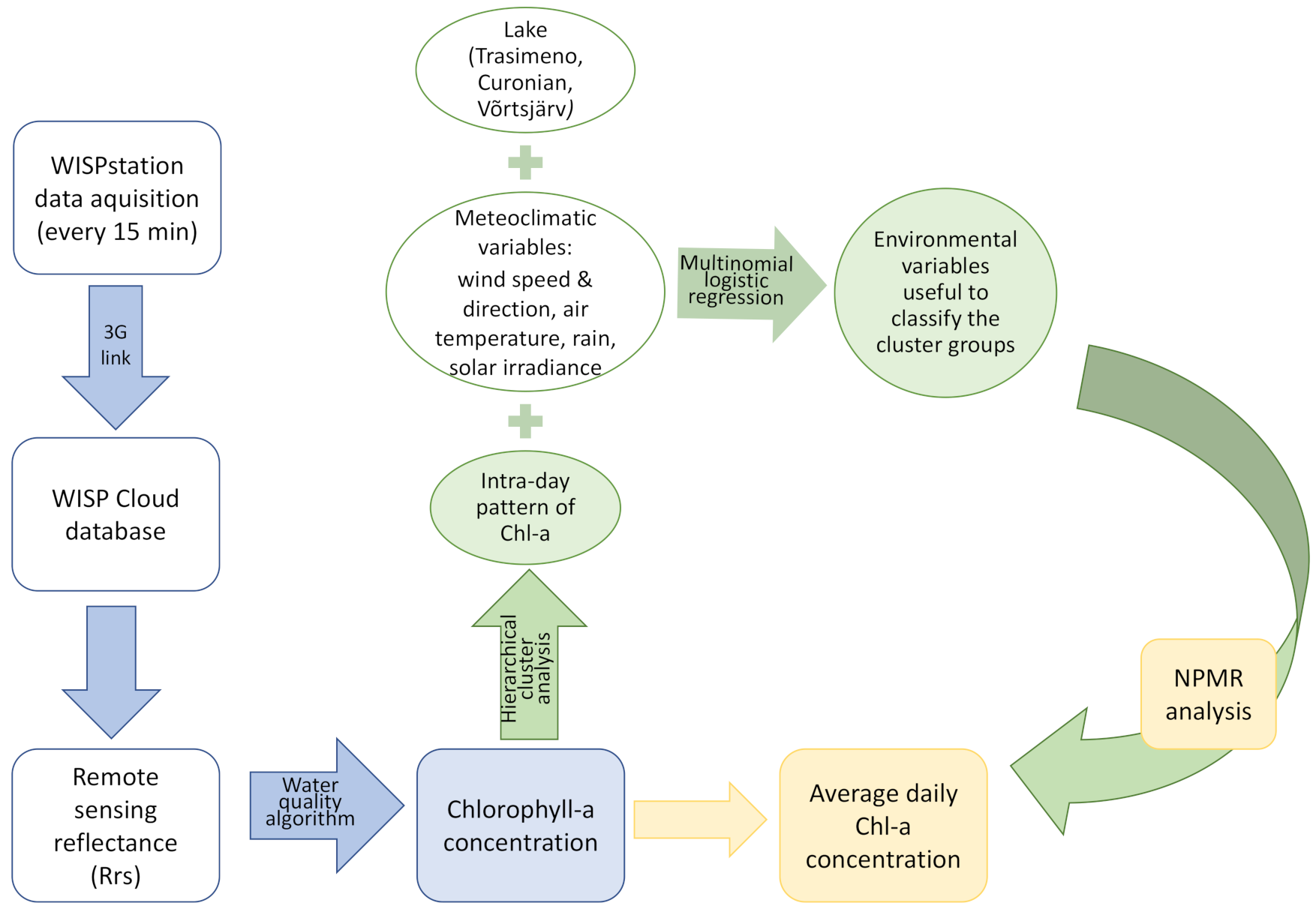
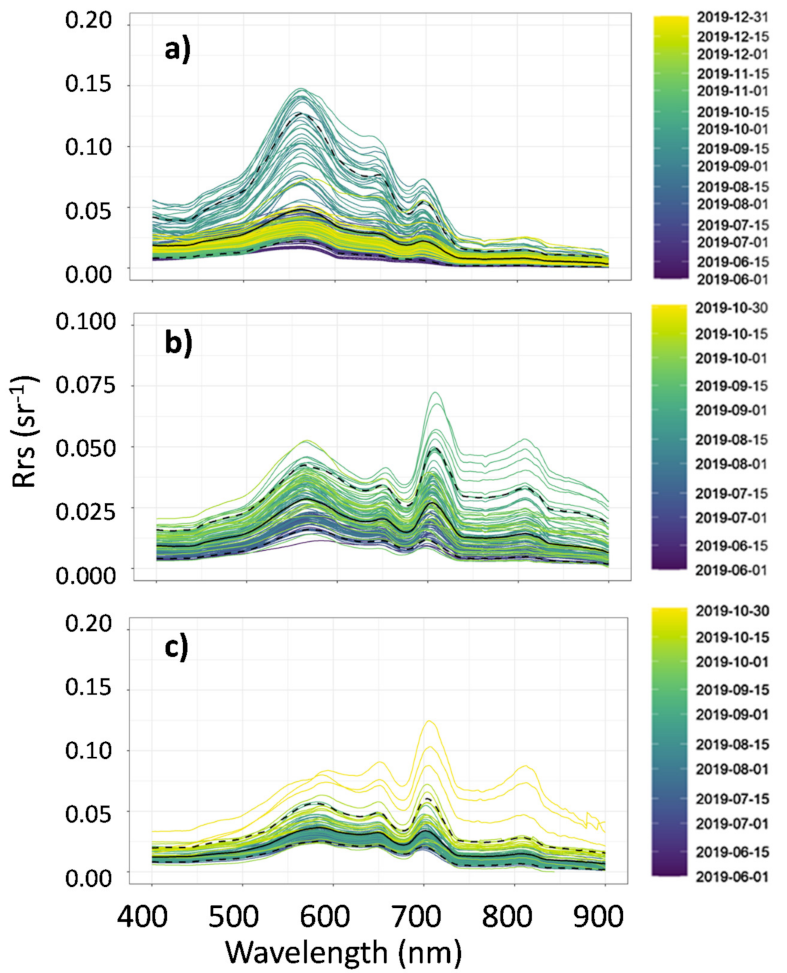
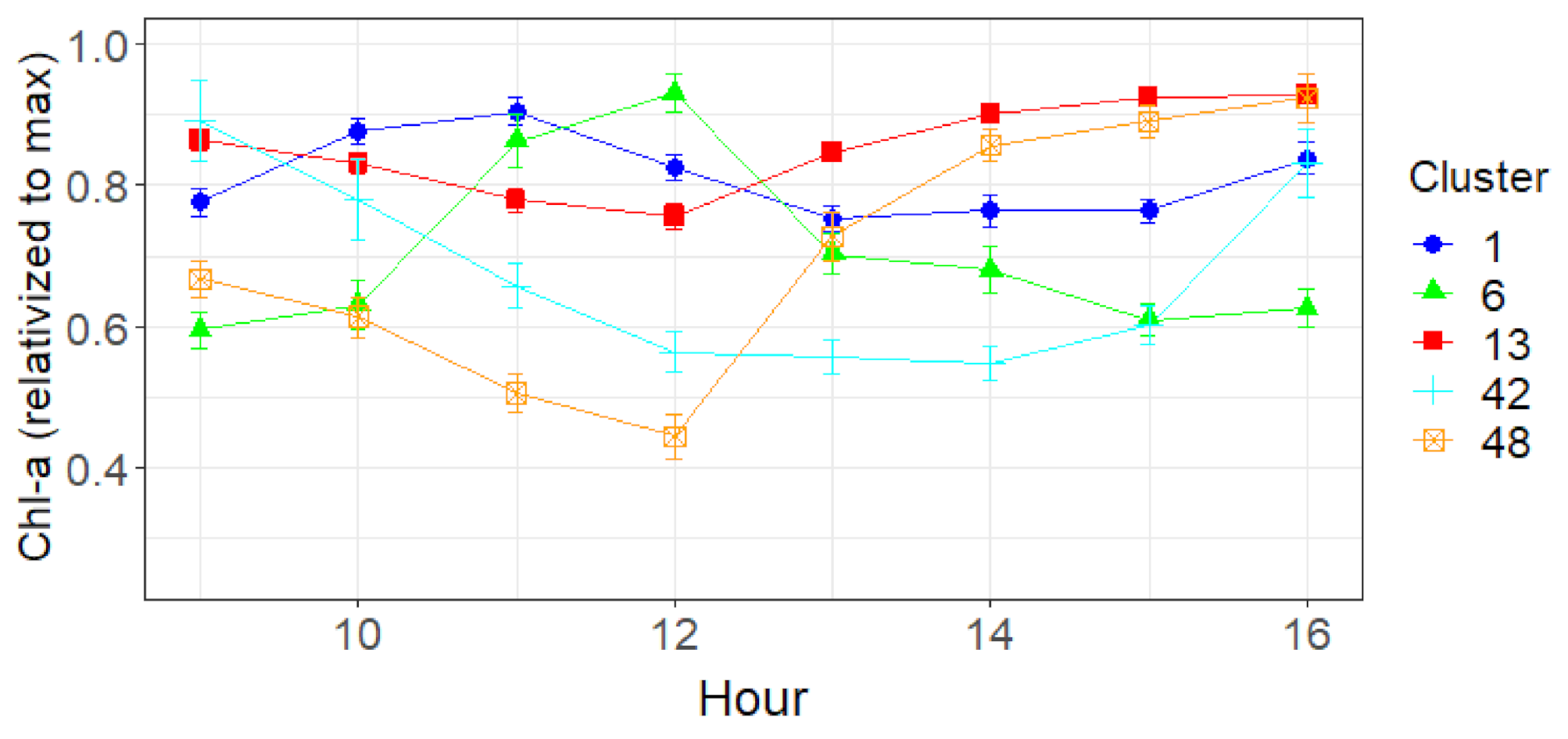
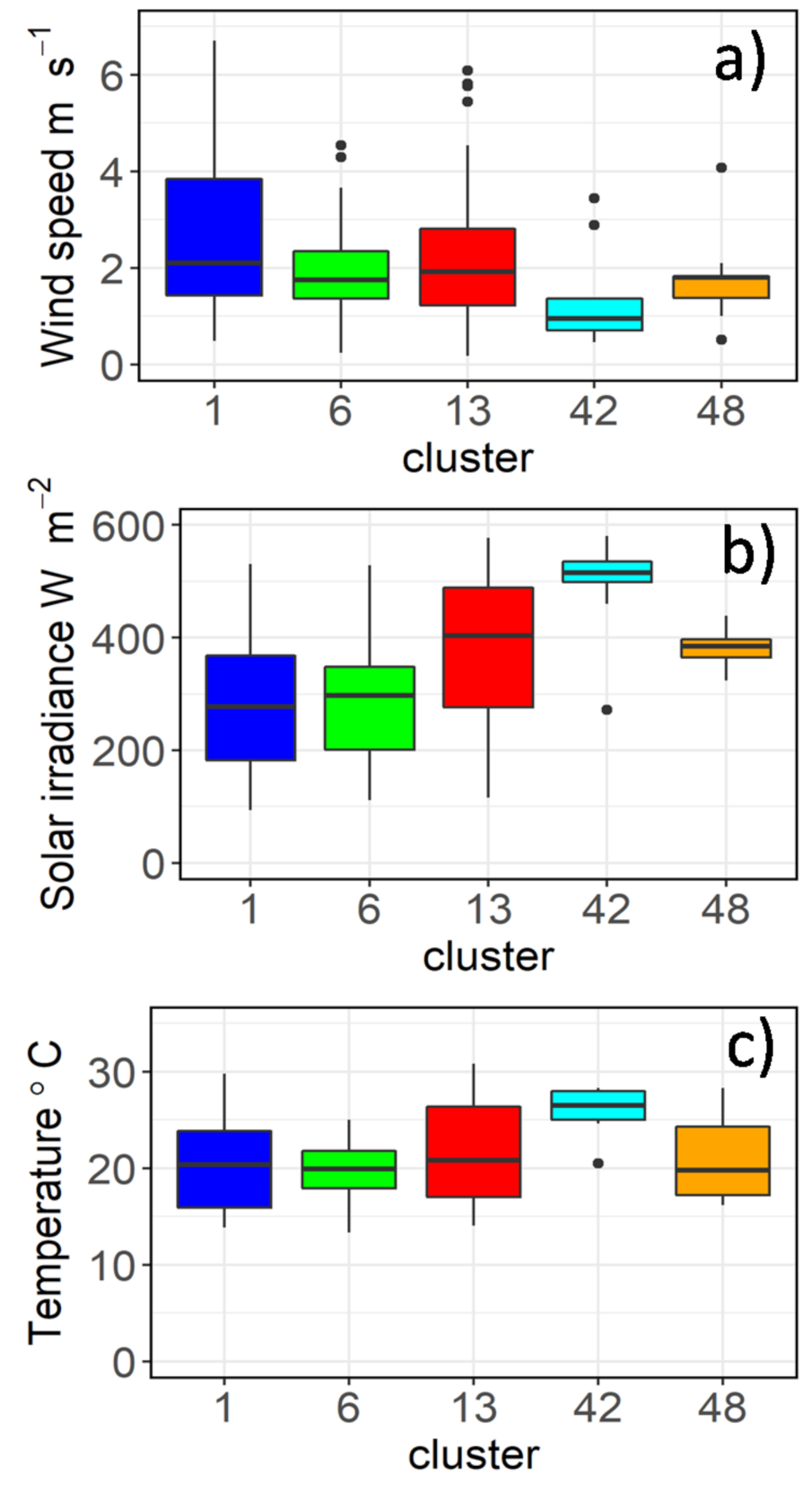
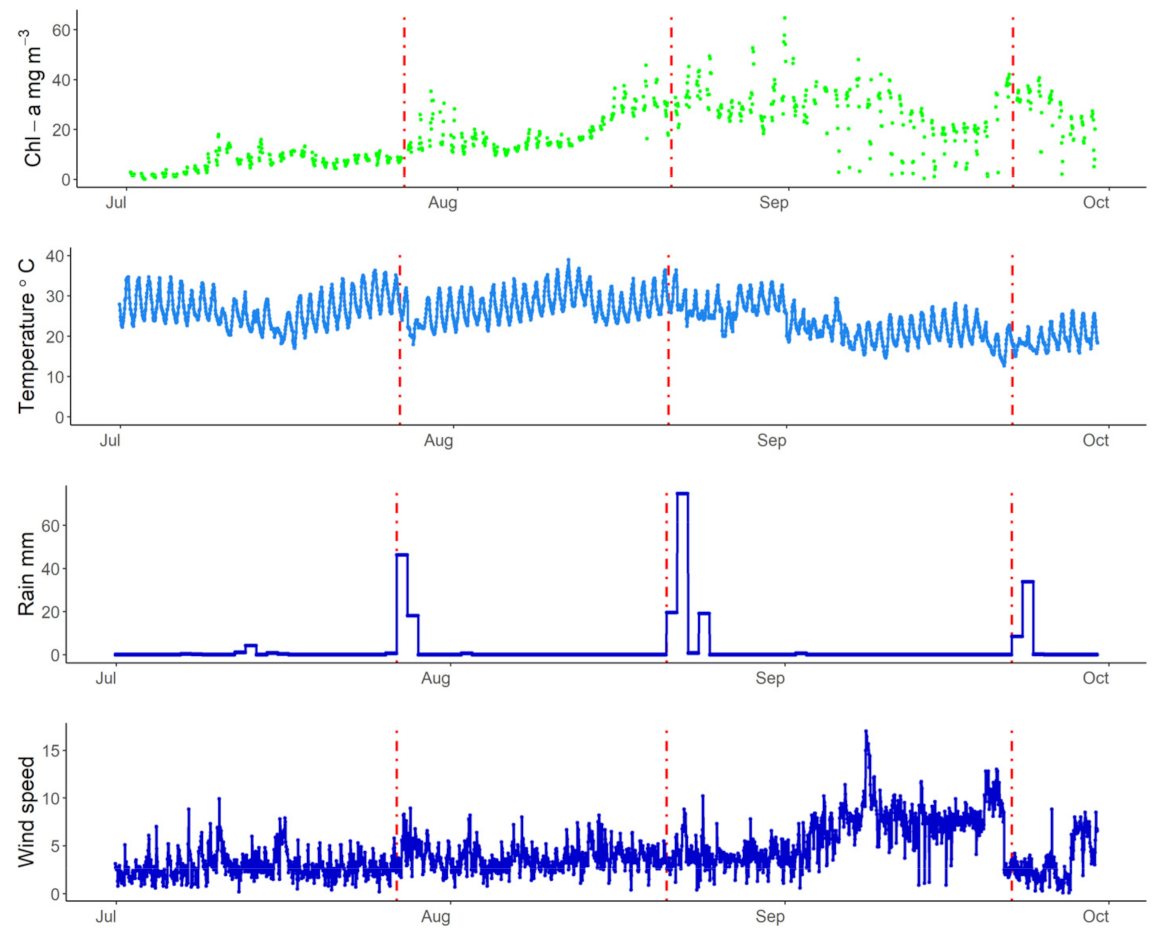
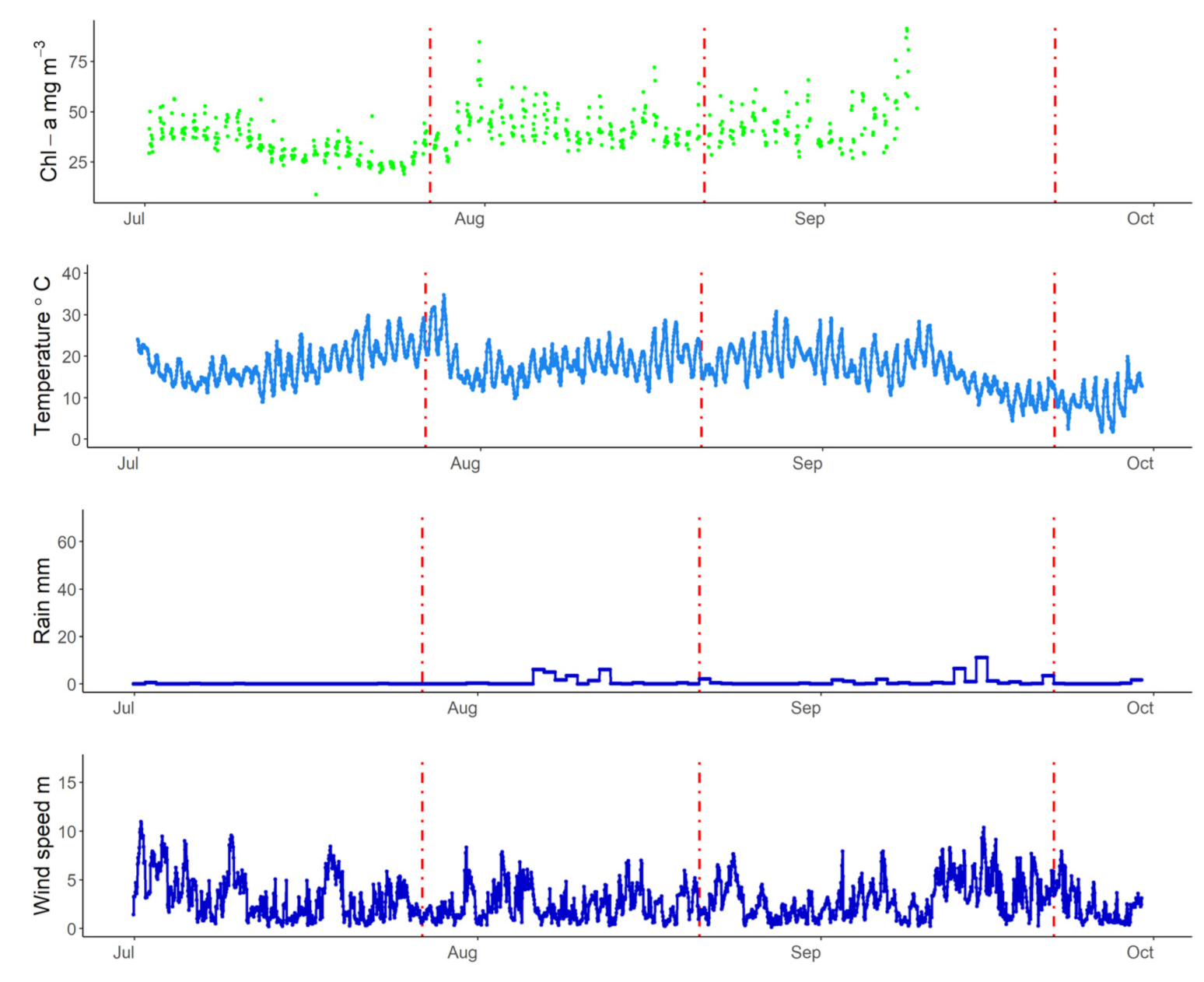
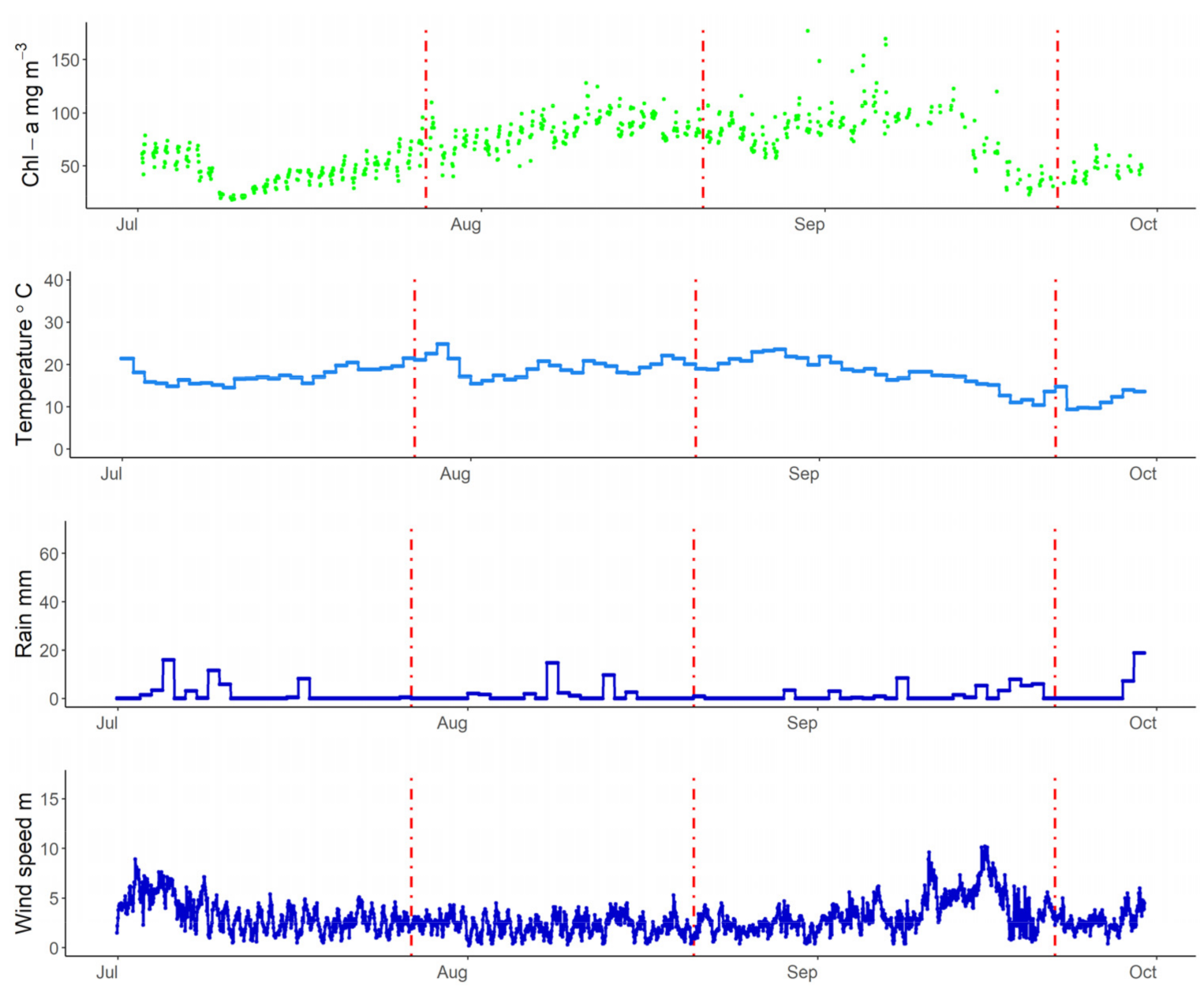
| Characteristics | Trasimeno | Võrtsjärv | Curonian Lagoon |
|---|---|---|---|
| Catchment area (km2) | 383 | 3100 | 97928 |
| Lake surface area (km2) | 121 | 270 | 1584 |
| Maximum depth (m) | 5.5 | 6 | 5.8 * |
| Average depth (m) | 4.0 | 2.8 | 3.8 |
| Water residence time | >20 years | ~1 year | 10–100 days |
| Total phosphorous (µg L−1) | 27 | 40 | 108 |
| Cluster | 1 | 6 | 13 | 42 | 48 | n |
|---|---|---|---|---|---|---|
| 1 | 56 | 47 | 26 | 0 | 0 | 32 |
| 6 | 3 | 0 | 2 | 0 | 0 | 17 |
| 13 | 41 | 53 | 66 | 80 | 100 | 50 |
| 42 | 0 | 0 | 6 | 20 | 0 | 10 |
| 48 | 0 | 0 | 0 | 0 | 0 | 11 |
| Lake | xR2 | Ave. Size | Variable1 | Sen. | Tol. | Variable2 | Sen. | Tol. | p |
|---|---|---|---|---|---|---|---|---|---|
| Curonian | 0.91 | 3.83 | Temp_7day | 0.29 | 0.68 | DOY | 0.56 | 3.45 | <0.05 |
| Võrtsjärv | 0.52 | 5.37 | Temp | 0.09 | 2.68 | DOY | 0.68 | 3.45 | <0.05 |
| Trasimeno | 0.87 | 5.13 | Wind speed | 0.10 | 1.63 | DOY | 0.75 | 3.45 | <0.05 |
Publisher’s Note: MDPI stays neutral with regard to jurisdictional claims in published maps and institutional affiliations. |
© 2021 by the authors. Licensee MDPI, Basel, Switzerland. This article is an open access article distributed under the terms and conditions of the Creative Commons Attribution (CC BY) license (https://creativecommons.org/licenses/by/4.0/).
Share and Cite
Free, G.; Bresciani, M.; Pinardi, M.; Giardino, C.; Alikas, K.; Kangro, K.; Rõõm, E.-I.; Vaičiūtė, D.; Bučas, M.; Tiškus, E.; et al. Detecting Climate Driven Changes in Chlorophyll-a Using High Frequency Monitoring: The Impact of the 2019 European Heatwave in Three Contrasting Aquatic Systems. Sensors 2021, 21, 6242. https://doi.org/10.3390/s21186242
Free G, Bresciani M, Pinardi M, Giardino C, Alikas K, Kangro K, Rõõm E-I, Vaičiūtė D, Bučas M, Tiškus E, et al. Detecting Climate Driven Changes in Chlorophyll-a Using High Frequency Monitoring: The Impact of the 2019 European Heatwave in Three Contrasting Aquatic Systems. Sensors. 2021; 21(18):6242. https://doi.org/10.3390/s21186242
Chicago/Turabian StyleFree, Gary, Mariano Bresciani, Monica Pinardi, Claudia Giardino, Krista Alikas, Kersti Kangro, Eva-Ingrid Rõõm, Diana Vaičiūtė, Martynas Bučas, Edvinas Tiškus, and et al. 2021. "Detecting Climate Driven Changes in Chlorophyll-a Using High Frequency Monitoring: The Impact of the 2019 European Heatwave in Three Contrasting Aquatic Systems" Sensors 21, no. 18: 6242. https://doi.org/10.3390/s21186242
APA StyleFree, G., Bresciani, M., Pinardi, M., Giardino, C., Alikas, K., Kangro, K., Rõõm, E.-I., Vaičiūtė, D., Bučas, M., Tiškus, E., Hommersom, A., Laanen, M., & Peters, S. (2021). Detecting Climate Driven Changes in Chlorophyll-a Using High Frequency Monitoring: The Impact of the 2019 European Heatwave in Three Contrasting Aquatic Systems. Sensors, 21(18), 6242. https://doi.org/10.3390/s21186242










